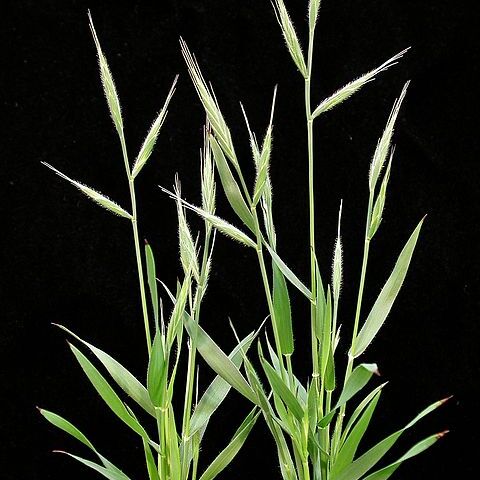Spikelets several-flowered, subterete except in anthesis, short-pedicelled, usually appressed, rather distant in simple racemes; glumes strongly nerved, the second broader and a little longer than the first; lemmas rounded on the back, obscurely nerved, awned from the tip; palea about as long as the lemma, strongly ciliate on the keels; caryopsis adnate to the palea.
Tufted or rhizomatous perennials, rarely annual. Leaf-blades flat and thin, or stiff and convolute. Inflorescence a raceme, the pedicels 1–3 mm. long. Spikelets 6–22-flowered; glumes 3–7-nerved; lemmas usually awned, rarely apiculate; palea a little shorter than the lemma, ciliolate on the keels, truncate.
Lemmas 7-9-nerved, oblong to oblong-lanceolate, densely imbricate at first, later somewhat spreading, mucronate or with a straight awn, dorsally rounded: callus very short, obtuse.
Caryopsis oblong to linear in outline, convex-concave, with an apical ciliate appendage, usually tightly enclosed by the palea; hilum filiform, very long.
Paleas slightly shorter than the corresponding lemmas, oblong, with the apex broadly obtuse to truncate, 2-keeled, pectinate-ciliate along the keels.
Ovary with a villous apical appendage or simply hairy; styles inserted at the appendage, short; stigmas plumose, laterally exserted.
Spikelets subsessile, solitary, several-to many-flowered, at first cylindric, later elatrally slightly compressed, usually awned.
Inflorescence a simple terminal raceme (pseudo-spike), with the spikelets alternating in 2 rows on opposite sides of the rhachis.
Lodicules 2, lanceolate, with the apex usually truncate, ciliate or more rarely glabrous.
Rhachilla disarticulating above the glumes and between the florets, glabrous, smooth.
Perennial or more rarely annual grasses of varying habits, often rhizomatous.
Florets hermaphrodite, all fertile but the uppermost usually reduced.
Description and distribution as for tribe.
Glumes unequal, 3-7(-9)-nerved.
Stamens 3, rarely 2.
Ligule membranous.


